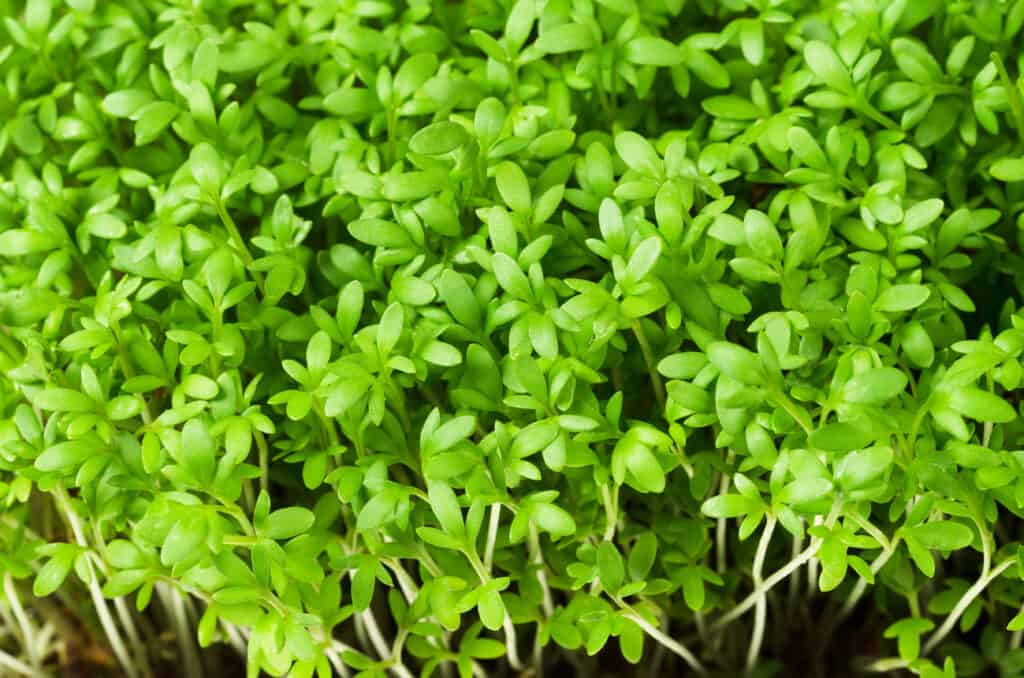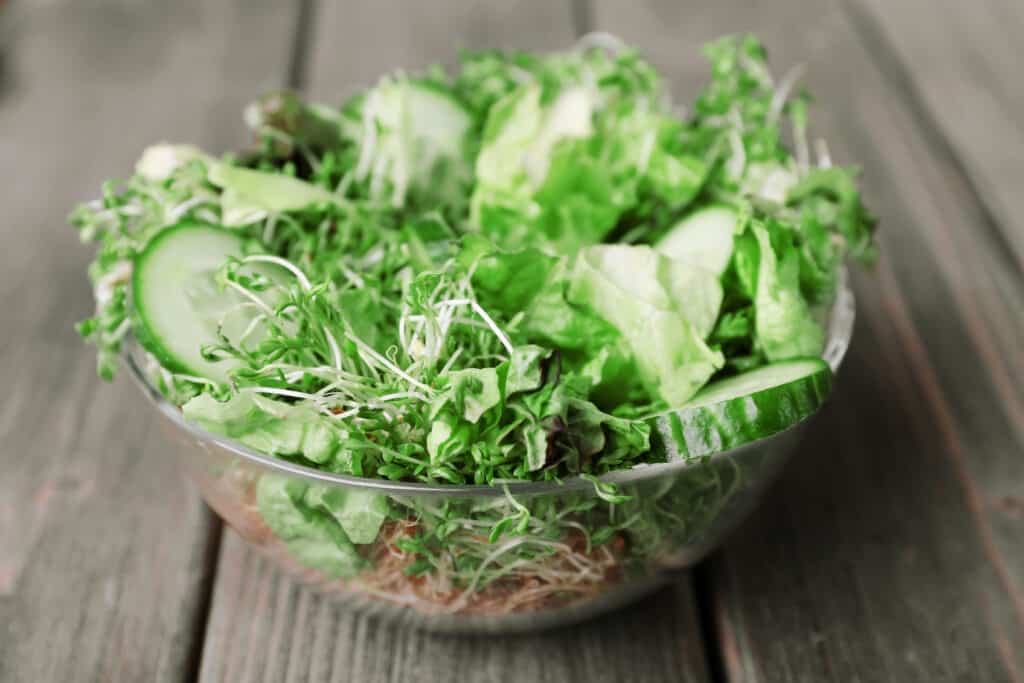Cress is a common name for more than a dozen sharp, pungent, small-leafed greens that can be added to salads and sandwiches, and soups and used as a base for roast beef or chicken.
Cress brings a dash of hot and spicy stir-fries and purées and can be finely chopped and added to butter, mashed potatoes, dumplings, or white sauces.
Articles of interest:
- How to Grow Herbs
- How to Start an Herb Garden
- Best Herbs for Container Growing
- Herbs for Cool Season Growing
- Grow 20 Herbs for Cooking

Garden and curled cress, Upland cress, and watercress are perhaps the best-known cresses. Most cresses are members of the mustard family so they all bring a peppery dash to other foods.
Types of cress

Garden cress
Garden cress also called peppergrass, and Curled Cress, a related variety (Lepidium sativum): Rather plain clover-like leaves that are eaten young in salads, sandwiches, soups, omelets, and with sliced hard-boiled eggs. The leaves of the curled cress are deeply cut and lacy-looking similar to parsley and chervil. All have a piquant, horseradish bite. Grows 6 to 12 inches (15-30 cm) tall and are harvested in spring and fall.

Upland cress
Upland Cress also called Early Winter Cress, American Cress, Belle Isle Cress, and Scurvy Grass (Barbarea verna): Tiny, dark green, deeply lobed leaves from dandelion-like rosettes used in salads or to add a peppery taste to mixed greens for cooking. Use as a garnish or flavoring. Mild, lingering sharpness and delicate, peppery taste. The Spring crop can grow hot-flavored in hot weather. Small plants grow 3 to 6 inches (7.5-15 cm) tall. A good winter greenhouse crop.

Watercress
Watercress (Nasturtium officinale): tiny lily-pad-shaped leaves that form mats of floating stems and leaves in moist soil and flowing water. Leaves and stems are eaten in salads and used in soups, canapés, and omelets. Blend with butter to make a tangy spread for sandwiches. The seeds can be made into mustard. Watercress is winter hardy and can be harvested year-round. The plant grows from 8 to 20 inches (20-51 cm) tall.
How to choose cress
- Select cress with whole, deep green leaves that have a peppery aroma.
- Avoid leaves that are yellowing, slimy, or unpleasant smelling.
- Some cress may be hydroponically grown and will come to market with their root balls attached.
- The flavor of cress deteriorates after flowering.
How to store cress
- Cress will keep in a plastic bag in the refrigerator for 3 to 5 days.
- Stand stems in a container of cold water and cover the tops with a plastic bag.
How to prepare cress
- Wash cress under cool running water, trim away the roots with scissors, pat dry with paper towels, or place in a salad spinner before using. Do this just before serving.
- To keep leaves crisp, do not let them soak.
- Tired leaves can be revived by rinsing in cool water.

Cress serving suggestions
- Use raw garden cress or watercress to lend a peppery flavor to salads and sandwiches. Use a mixture of mustard and cress seedlings for a “mustard and cress” green salad. Use cress as spicy greens and garnishes.
- Cook cress as you would spinach. Sauté cress in butter for 10 minutes, and serve as a vegetable. Use cress in stir-fries. You can boil cress with other greens like mustard and corn salad.
- Purée cress to make a chilled soup. Thicken cress soup with potatoes and cream.
- Blend cress with scallions, yogurt, or buttermilk, and serve with salmon.
- Serve as a bed for roast beef or roast chicken so that it wilts and absorbs juices.
How to wilt cress
- Cook-wilt cress in a saucepan or a skillet with just the water that clings to the leaves after washing.
- Add a sprinkling of salt and place the pan over low heat.
- Cover the pan so that the cress steams in its own liquid.
- Shake the pan occasionally to prevent leaves from sticking to the bottom. Cress will cook in 4 to 6 minutes wilting down to about an eighth of its volume.
- Drain and press out the remaining liquid.
- Chop and serve with butter.
How to purée cress
- Wilt the cress as directed above.
- Drain or dry the leaves as much as possible.
- Purée in a food processor or chop it by hand, add 4 to 6 tablespoons of melted butter, 2 tablespoons of heavy cream then blend well.
Cress flavor partners
- Cress has a flavor affinity with buttermilk, cucumber, egg, goat cheese, mushrooms, potatoes, rice, roasted meats, tofu, tomatoes, and yogurt.
Cress nutrition
- Cress contains vitamins A and C and potassium.

More about cress
- Watercress is native to South America and was brought from Peru to Europe in the late seventeenth century. The Latin genus name for watercress, nasturtium, comes from the root words nasum (nose) and tortus (twisted), or twisted nose for the plant’s peppery kick.
- Garden cress and Upland cress are native to Europe where they have grown wild near slow-running waterways since ancient times. These cresses came into broad cultivation in the nineteenth century.
Related articles:
How to Plant, Grow, and Harvest Cress
How to Prepare and Serve Cress
How to Plant, Grow, and Harvest Microgreens
Also of interest:
- Anise
- Anise Hyssop
- Arugula
- Basil
- Bay
- Bee Balm
- Borage
- Calendula
- Caraway
- Catnip
- Chamomile
- Chervil
- Chives
- Cilantro-Coriander
- Clary
- Costmary
- Cress
- Dill
- Fennel, Sweet
- Horseradish
- Hyssop
- Lavender
- Lemon Balm
- Lemon Verbena
- Lovage
- Marjoram
- Mint
- Nasturtium
- Oregano
- Parsley
- Perilla
- Rosemary
- Sage
- Salad Burnet
- Savory
- Scented Geranium
- Shiso
- Sorrel
- Stevia
- Sweet Cicely
- Tarragon
- Thyme
Articles of interest:
Best Herbs for Container Growing
Garden Planning Books at Amazon:
- Vegetable Garden Almanac & Planner
- Kitchen Garden Grower’s Guide Vegetable Encyclopedia
- Vegetable Garden Grower’s Guide
- Tomato Grower’s Answer Book















